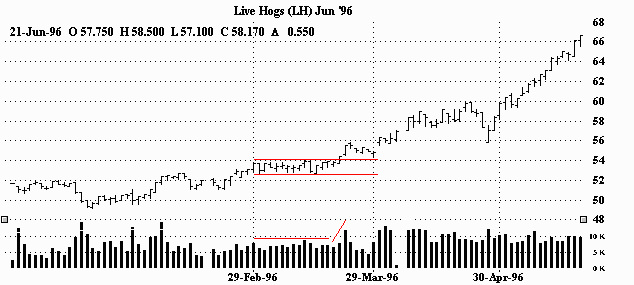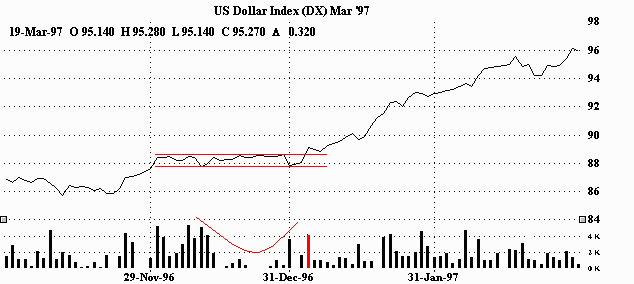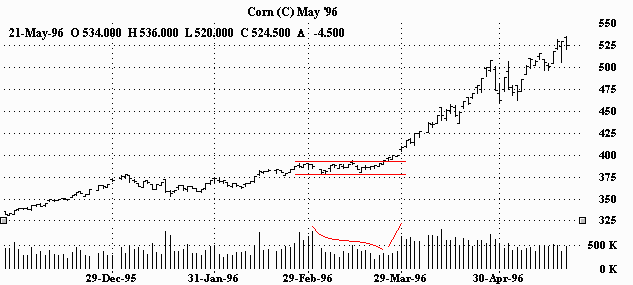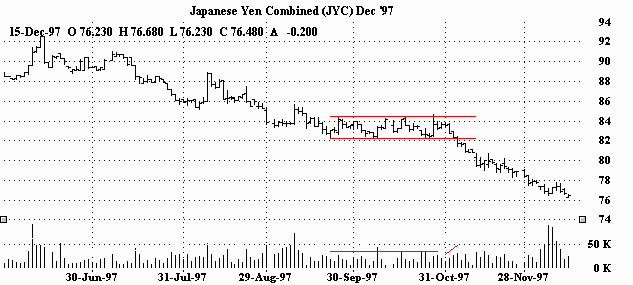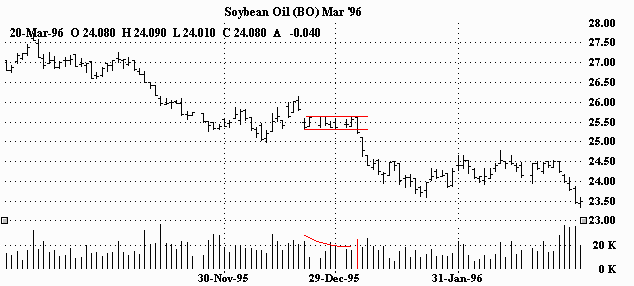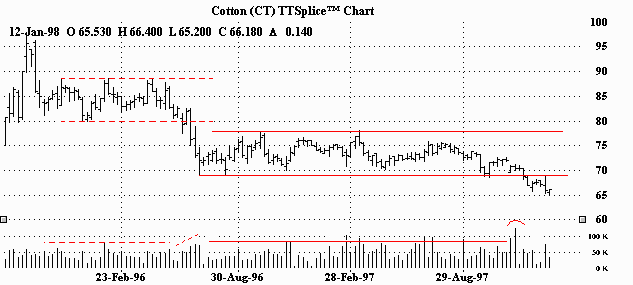CHART EXAMPLES OF RECTANGLE PATTERNS RECTANGLE IN AN UPTREND (BULLISH)
Rectangle pattern in an uptrend. The market goes into roughly a three week consolidation before it finds its resolve and pushes higher. There is a general lessening and sort of balance to volume during the formation, but there is a clear increase on the breakout. (It's interesting to note that the volume seems erratic prior to the consolidation, kind of balanced during, and while still generally balanced as the market moves away from the rectangle, noticeably heavier.)
RECTANGLE IN THE BEGINNING AN UPTREND (BULLISH)
This rectangle in the beginning of an uptrend kept the market guessing for a month before resuming what it had started (uptrend.) This lengthy indecision saw volume dive. But the breakout seemed to wake everybody up. As you can see it was made on heavy volume. (By the way, a line chart was used in this example for easier viewing.)
RECTANGLE IN AN UPTREND (BULLISH)
Another month long rectangle in an uptrend. But, there's no looking back once the market resolves itself. Volume decreases during the wait. You can see that somewhere in the middle of the rectangle, there is an attempted breakout. The market pokes through the top 'parameter' only to be turned back, closing lower than it opened. You can also see the short lived spike in volume as well. However, when the market fails to violate the bottom 'parameter', the market charges back up. And even before the ultimate upside breakout, volume starts expanding on the trek higher. The breakout finally happens and is accomplished on strong volume.
RECTANGLE IN A DOWNTREND (BEARISH)
Here we have a rectangle in a downtrend. This one lasted for about six weeks. After a pretty big fall, the market consolidated before determining where to go next. Obviously, they figured it out, and headed off in the direction they started in (down.) Volume kind of thins out during this sideways period and then picks up as it heads for the bottom of the rectangle one last time and breaks through it. Notice that just prior to the downside resolution there was an attempted (failed) breakout to the upside. The markets inability to follow through was quickly exploited by the 'bears', as the market collapsed only a handful of days later.
RECTANGLE IN A DOWNTREND (BEARISH)
Rectangle in a downtrend. The market gets rocked, and bounces a bit, before settling into a two week sideways pattern. The market then resolves itself and blows through the bottom of the rectangle. Volume can best be described as a bit lighter but erratic during the pattern. However, volume is clearly heavier on the break lower.
RECTANGLE(S) IN A DOWNTREND (BEARISH)
Now here's an interesting one. First, it should be noted that this is a weekly chart. Price and volume encompass a full weeks worth of activity. Second, you can make a case that we actually have two rectangles. And each rectangle is quite lengthy. The first one, while not perfect in structure, still has an unmistakable rectangular appearance with easily recognizable 'parameters'. After the first breakout, the market falls into another prolonged trading range (over a year.) This one also has a clear rectangular (sideways) appearance (and is also better in structure.) Volume is a bit more ambiguous. There aren't any startling changes in the volume readings, but there does appear to be more activity on the move out of the rectangles than inside of them. And as for the second pattern, volume appears to pick up on the last attempt at the bottom 'parameter', seemingly setting the stage for the break. Lastly, notice that the market was unable to reach the top 'parameter' on its last rally. That more than likely was the encouragement the 'bears' needed to press the market.
The information contained here was gathered from sources deemed reliable, however, no claim is made as to its accuracy or content. This does not contain specific recommendations to buy or sell at particular prices or times, nor should any of the examples presented be deemed as such. There is a risk of loss in trading futures and futures options and you should carefully consider your financial position before making any trades. The reference to statistical probabilities does not pertain to profitability, but rather to the direction of the market. The size and the duration of the markets move, as well as entry and exit prices ultimately determines success or failure in a trade and is in no way represented in these statistics. This is not, nor is it intended to be, a complete study of chart patterns or technical analysis and should not be deemed as such.
Futures and options trading carries significant risk and you can lose some, all or even more than your investment.
|
